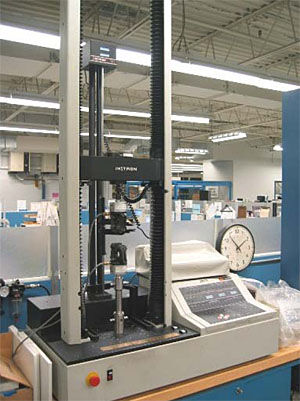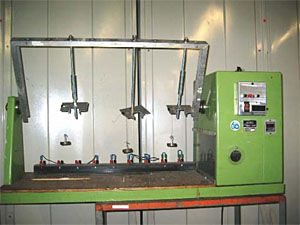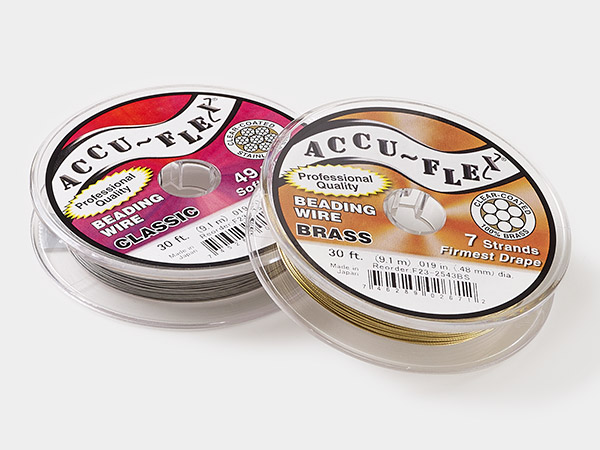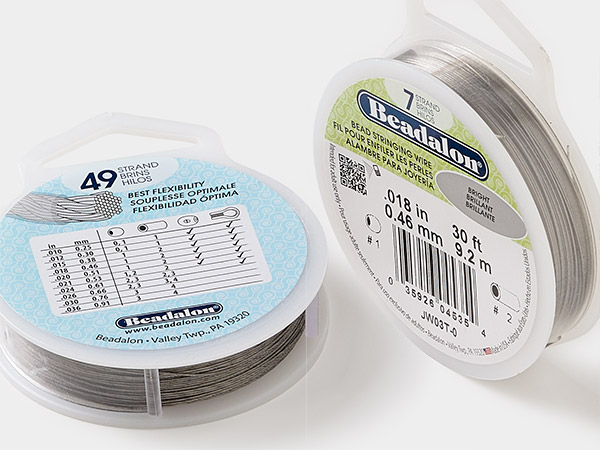Independent Lab Report
Comparison Testing on Three Brands of Coated Jewelry Wire
Lab: OnSpeX™
Report No:1-05147-001 Date: July 22, 2005
Customer Contact Information:
Company Name: Fire Mountain Gems and Beads
Address: One Fire Mountain Way
Grants Pass, OR 97526
Tel: (541) 956.7700
Fax: (541) 476.6129
Test Request:
To conduct comparison testing on three brands of coated jewelry wire, size .024 in, 49 strand.
Tested By: George Stoddart, P. Eng Technical Specialist
Signed By: Terry Drew, Director, Technical Services
Wire Names:
Black = S1: Accu-Flex® Beading Wire
Bronze = S2: Beadalon® Beading Wire
Clear (grey color) = S3: Soft Flex® Beading Wire
Executive Summary:
Tensile Strength: In all 3 cases, materials exceeded their marked load rating of 40lbs., with S3 having the greatest strength, followed by S1 and then S2. It has been assumed that the ''Heavy'' rating for S3 is equivalent to 40lbs.
Resistance to Elongation: Of the 3 materials tested, S2 proved to be the most resistant to elongation having the lowest percentage elongation at 1.41% (Average). This was followed by S3 at 2.33% and S1 at 2.64%
Resistance to Permanent Elongation: Testing for resistance to permanent elongation illustrated that all 3 materials were comparable. All samples supported 75% of their tensile strength with no evidence of elongation or permanent elongation.
Resistance to Kinking: For this test, S1 and S2 displayed the greatest resistance to kinking as there was no measurable result until mandrel sizes were reduced to 0.114'dia. Visible kinking occurred for S3 at 0.177''dia.Flexibility: Upon receipt of test samples, the test for flexibility was modified to provide more meaningful data. Please refer to the test method now described in this report for further detail. On completion of this test, all samples were judged equal in their ability to endure repetitive flexing.
Jacket Adhesion: As explained in the following report, the adhesion properties between jacket and core were greater than the strength of the jacket material alone, and as such, the jacket material broke in every case, before adhesion could be broken. Under a modified testing approach, strength of jacket was then determined with S3 having the strongest material, followed by S1 and S2.
1.0 General Properties:
For the purpose of this evaluation samples of jewelry beading / stringing wire were ordered directly by OnSpeX, and delivered directly to our testing facilities in Toronto, Ontario. Samples ordered and subsequently tested were:
- S1: Accu-Flex®, Platinum Quality, Professional Quality Beading Wire (Purchase Price: $ 6.60 US+ shipping)
- S2: Beadalon, Professional Series, Bead Stringing Wire (Purchase Price: $ 9.50 US + shipping)
- S3: Soft Flex, Beading Wire (Purchase Price: $ 10.79 + shipping),
with each consisting of the following properties:
Diameter: .024 in.
Strands: 49
Test Strength: 40 lb.*
*No test strength was specified for the Soft Flex sample. It was identified as ''Heavy''
For samples ''As Received'', please refer to Figure 1
2.0 Test Results:
Test Code: Tensile Strength
Standard/Reference: OnSpeX / Fire Mountain
Test Requirement/Method: Perform standard tensile strength test on each sample and document breaking force.
Comments / Observations: Three samples of each material were subjected to tensile testing using ''Instron'' test equipment (refer to Figure 2). Results shown below include both overall average and actuals for each specimen.
S1: Average 50.9 lbs. (Actuals 50.8, 50.8 and 51.1)
S2: Average 49.4 lbs. (Actuals 49.7, 49.5 and 49.0)
S3: Average 65.5 lbs. (Actuals 65.6, 65.6 and 65.6)
Test Code: Resistance to Elongation
Standard/Reference: OnSpeX / Fire Mountain
Test Requirement/Method: Using an ink surface marker, gauge marks will be applied to each specimen, 2'' before and 2'' following the centre point of the specimen. Specimen will then be elongated to breaking point and any increase in distance between gauge marks recorded.
Comments / Observations: Three samples of each material were subjected to elongation testing using ''Instron'' test equipment (as illustrated). Percentage elongation results, to the point of failure (breakage) are as outlined below. Results shown below include both overall average and actuals for each specimen.
S1: Average 2.64% (Actuals 2.50%, 1.98%, 3.43%)
S2: Average 1.41% (Actuals 1.37%, 1.45%, 1.40%)
S3: Average 2.33% (Actuals 1.69%, 3.30%, 1.99%)
Test Code: Resistance to Permanent Elongation
Standard/Reference: OnSpeX / Fire Mountain
Test Requirement/Method: Test specimens will be surface marked as defined under ''Resistance to Elongation'' and required to support a weight representing 75% of the average tensile strength recorded above, for a period of 10 minutes. Following this stress, specimens will be allowed to rest for a further period of 10 minutes, following which any extension beyond the original 4'' gauge marks will be documented.
Comments / Observations: One sample of each material was subjected to elongation forces as described above. In all cases, no permanent elongation was measurable. This finding is supported by the marginal elongation findings recorded for the previous test.
Test Code: Resistance to Kinking
Standard/Reference: OnSpeX / Fire Mountain
Test Requirement/Method: A test specimen will be cut from each sampling provided and wrapped for 15 revolutions around a mandrel of 0. 25'' dia. While wrapped, the sample will be required to support a weight equal to 25% of the tensile strength recorded for that material, for a period of 1 minute, without kinking. This test will be repeated, using fresh samples, and decreasing mandrel sizes, until a permanent kink has formed. The mandrel size, at which the kink occurs, will be documented, as will the diameter of the mandrel size at which the sample fails to straighten without intervention.
Comments / Observations: One sample from each sample spool was subjected to Resistance to Kinking using the method described above, and each starting with a mandrel of 0.25'' in dia. The following shows the mandrel size at which a permanent ''set'' (kink) was identified.
S1: Permanent set at mandrel size 0.114'' dia.
S2: Permanent set at mandrel size 0.114'' dia.
S3: Permanent set at mandrel size 0.177'' dia.
Test Code: Flexibility
Standard/Reference: OnSpeX / Fire Mountain
Test Requirement/Method: A 12'' test specimen will be cut from each spool sample and mounted, to a flexing machine as illustrated in Figure 2. Samples will then be subject to 45 degrees lateral flexing, in 2 directions, for 5,000 cycles, while supporting a weight of 1/2 lb (225kg). At no time during this test shall samples fail or break.
Comments / Observations: One sample from each material batch was subjected to repeated flexing as described above. All samples successfully met 5,000 operations (cycles) without breakage. Refer to Figure 3 for illustration of equipment used.
Test Code: Jacket Adhesion
Standard/Reference: OnSpeX / Fire Mountain
Test Requirement/Method: Samples from each material and size will be tested to determine the degree of adhesion between wire core and outer jacket (coating), by means of elongation test.
Comments / Observations: The initial purpose of this test was to determine the force at which the outer covering (jacket) would separate from the wire core, thereby causing the jacket to slip. Through testing it was determined that the adhesion factor between core and out covering, in all cases, exceeded the mechanical strength of the jacket material. In all cases, the jacket material failed (broke) before adhesion could be broken. The force at which the jacket material broke is as stated below.
S1: Jacket breakage at 0.76 lbs.
S2: Jacket breakage at 0.73 lbs.
S3: Jacket breakage at 1.10 lbs.
Shop for Your Materials Here:
Have a question regarding this project? Email Customer Service.
Copyright Permissions
All works of authorship (articles, videos, tutorials and other creative works) are from the Fire Mountain Gems and Beads® Collection, and permission to copy is granted for non-commercial educational purposes only. All other reproduction requires written permission. For more information, please email copyrightpermission@firemtn.com.
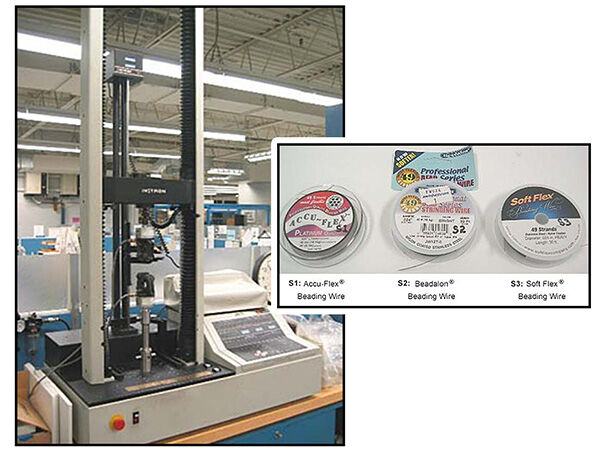
.jpg)
